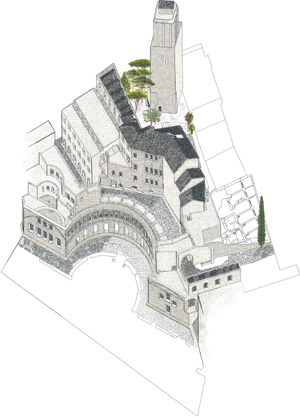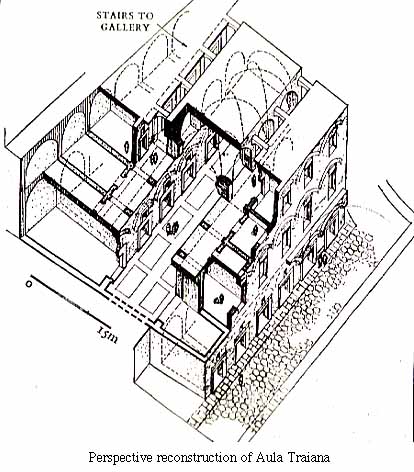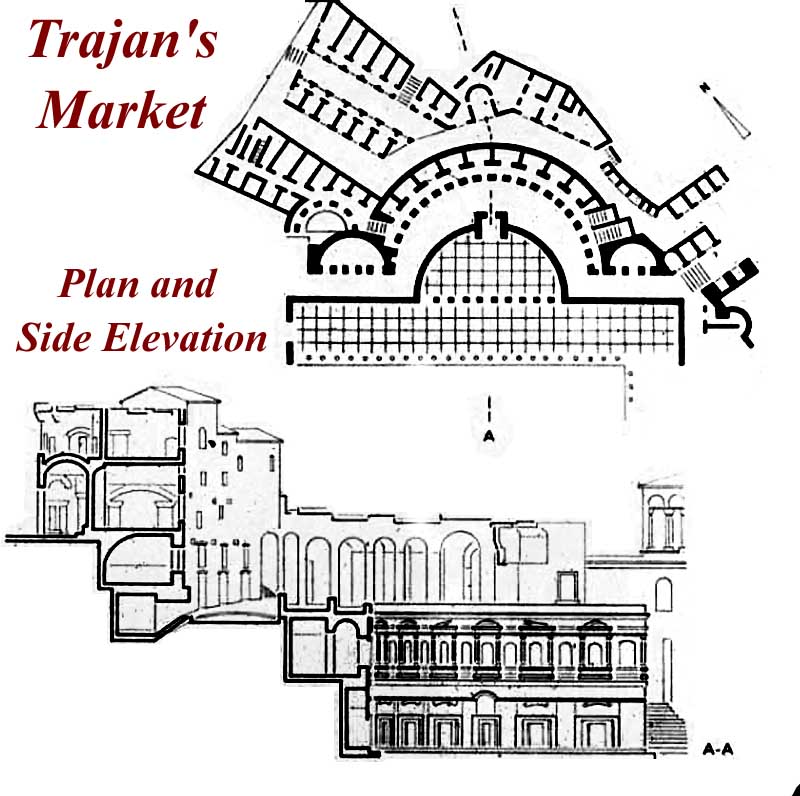Markets
of Trajan

The Market of Trajan was designed
by the Trajan's architect, Apollodorus of Damascus, and built between 94
and 113 AD. The markets were a commercial center of about 150 shops and
offices, set into the side of the Quirinal Hill and completing Trajan's
Forum. The market complex was the world's first real shopping mall. There
were "stip malls", i.e., rows of shops, sometimes on two levels in other
parts of the Republican Forum-- on the Forum side of the Basilica Aemelia
and the back side of the Basilica Julia, but this multi-level "mall" was
an entirely new concept. The complex included a large semi-circular room
that was apparently used as a lecture hall or as an Odeon. The semicircular
motif was repeated in streets through and around the shopping area. Stores
and offices spread up the hill in three "belts" and halls at the end of
the hemicycles reinforced the shape of the complex.
The whole of the uphill side of
the market was enclosed in a high thick wall of peperino stone which is
very resistant to fire -- apparently a precaution, similar to that already
taken behind the forum of Augustus and later behind that of Nerva to prevent
the frequent fires in the Sabura neighborhood from spreading to and damaging
buildings in the Forums.
Structural engineers will notice
immediately that the walls of the various levels of shops buttress the
new cliff on the forum side of the Quirinal hill. Trajan had cut back the
hillside to make room for his vast new Forum. It was a natural to slip
shops into the spaces between the buttresses to make commercial use of
spaces in a typically practical Roman solution to a construction necessity.

The markets are the best-known
example of modular Roman commercial construction in concrete. It is a complex
architectural structure that had six major levels, though the pavements
of a few corridors and rooms are at heights between the levels. The plan
of each superposed level is not necessarily vertically congruent with the
one below. The careful planning is evident in the relationships between
the streets and shops, the functional locations of the stairways and ramps,
and the openings that were built to bring adequate lighting and ventilation.
The base of the semicircular brick complex is set into the hill, above
which are tiers of terraces ascending the slope. At the upper end of the
slope, a two-story market hall with a series of groined vaults was lined
with shops on each side of a central promenade with a balcony level and
clerestory openings above. The brick facades have brickwork arches and
pediments and travertine lintels. Slots in the thresholds of the shops
indicate that they had sliding/folding doors similar to some found in Pompeii.
The whole site was opened to the
public in 2001, and several indoor and outdoor art exhibits have already
been mounted in market spaces. Ramps and elevators have been added to make
the markets accessible to the handicapped. It is also now possible to move
through the markets to the medieval Milizie Tower, where a small museum
has been opened. Access to the top of the Milizie Tower is not yet possible.
(The tower is visible in the first illustration on this page.)


In the plan and side elevation it is possible to see
how the market buttresses the end of the Quirinale Hill where it was cut
away to make space for the Forum of Trajan.



